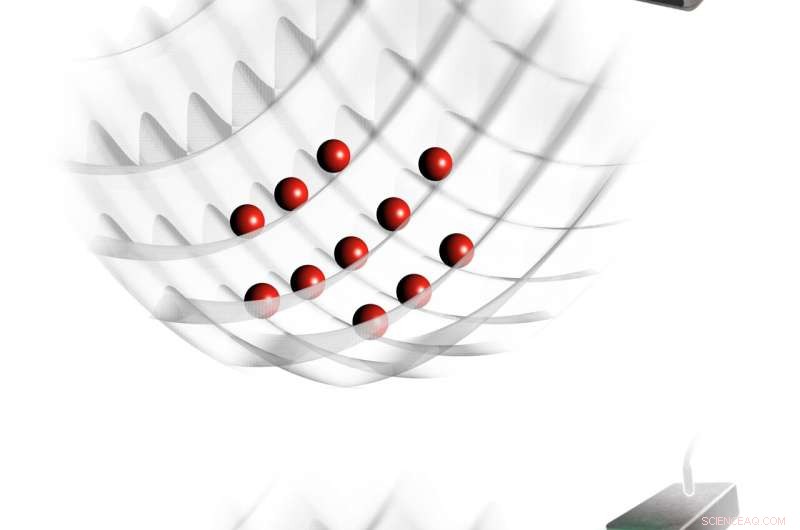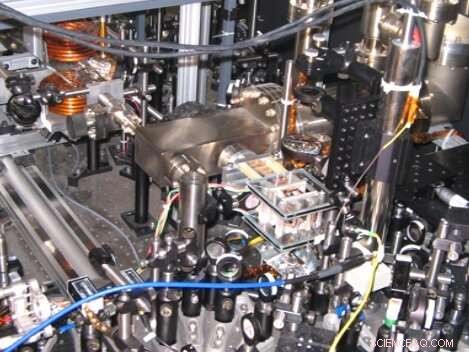O estudo introduz polaritons de onda de matéria sem perda em um sistema de rede óptica

Uma representação artística dos resultados da pesquisa no estudo do polariton mostra os átomos em uma rede óptica formando uma fase isolante (esquerda); átomos se transformando em polaritons onda-matéria via acoplamento a vácuo mediado por radiação de micro-ondas representada pela cor verde (centro); polaritons tornando-se móveis e formando uma fase superfluida para forte acoplamento a vácuo (direita). Crédito:Alfonso Lanuza/Schneble Lab/Stony Brook University.
Polaritons são quasipartículas que são formadas quando fótons se acoplam fortemente com excitações da matéria. Essas quase partículas, que são metade luz e metade matéria, sustentam o funcionamento de uma ampla gama de sistemas quânticos fotônicos emergentes, incluindo dispositivos nanofotônicos baseados em semicondutores e sistemas eletrodinâmicos quânticos de circuito.
Pesquisadores da Stony Brook University introduziram recentemente um novo sistema de polariton no qual a excitação da matéria é substituída por um átomo em uma rede óptica e o fóton por uma onda de matéria atômica. Este sistema, introduzido em um artigo publicado na
Nature Physics , resulta em polaritons de onda de matéria e pode abrir possibilidades interessantes para o estudo da matéria quântica polaritônica.
"Alguns anos atrás, ficamos interessados na ideia de usar átomos ultrafrios para simular o comportamento dinâmico de emissores quânticos", disse o Dr. Dominik Schneble, chefe da equipe de pesquisadores que realizou o estudo, ao Phys.org. "Acontece que é possível construir um átomo artificial que emite ondas de matéria espontaneamente, da mesma forma que um átomo emite um fóton espontaneamente (como descrito pelo chamado modelo de Weisskopf-Wigner)."
Schneble e seus colegas mostraram que usar esse átomo artificial em vez de um "átomo real" para estudar o comportamento dinâmico de emissores quânticos tinha algumas vantagens. Mais notavelmente, o sistema artificial permitiu que os pesquisadores sintonizassem livremente parâmetros importantes, como a energia de excitação do emissor e seu acoplamento ao vácuo.
O emissor artificial que eles criaram inicialmente consistia em uma armadilha microscópica (ou seja, um poço da rede óptica), que era preenchido com um único átomo. A equipe implementou um mecanismo que permitiu que um único átomo mudasse sua rotação e fosse liberado espontaneamente em um guia de ondas de matéria, no qual as próprias armadilhas estavam incorporadas.
“Crucialmente e em contraste com os emissores quânticos convencionais, este era o único mecanismo de decaimento permitido e a radiação não poderia escapar em outro lugar”, explicou Schneble. "Em um artigo que saiu na
Nature em 2018, observamos que a decomposição nessas condições pode ter características bastante exóticas. Em particular, quando definimos a energia de excitação como negativa (pode soar estranho, mas também pode valer para 'emissores reais' em um material de banda fotônica), a radiação de onda de matéria emitida, tendo energia negativa, não poderia escapar e em vez disso, pairava em torno do emissor como uma nuvem coerente de excitações de vácuo."

An artistic rendering of the research findings in the polariton study shows the atoms in an optical lattice forming an insulating phase (left); atoms turning into matter-wave polaritons via vacuum coupling mediated by microwave radiation represented by the green color (center); polaritons becoming mobile and forming a superfluid phase for strong vacuum coupling (right). Credit:Alfonso Lanuza/Schneble Lab/Stony Brook University.
In their new study, Schneble and his colleagues leveraged the fact that the emitters they had implemented (i.e., the wells) were indeed part of a periodic lattice that can also contain many atoms. As a result, transport and interaction effects inside the lattice can become important.
"If we for a moment neglect the emission features but just look at the lattice, these atoms can by themselves tunnel, or hop, from site to site," Schneble said. "Whether or not this happens depends on the strength of the hopping compared to the energy cost due to the repulsion between two or more atoms on the same lattice site (this is known as the Bose-Hubbard model)."
The key objective of the researchers' study was to determine what happens when they turned on the emission features on their optical lattice system, especially at a negative energy where radiation cannot escape. Interestingly, they found evidence that hovering matter waves tended to leak into neighboring wells.
In a neighboring well, an inverse decay (i.e., absorption) process can convert the hovering matter wave back into a trapped atom. Through this process, the originating well simultaneously empties out.
"This effectively means that the trapped atom, dressed in the matter-wave cloud, has an additional mechanism to hop between lattice sites," Schneble said. "On the other hand, the matter waves in the waveguide can never freely travel on their own and, being chained to the atoms in the lattice, all they can do is hop along."
As a result, in this system the matter waves become less mobile, or "heavier," while the atom becomes more mobile, or "lighter." The matter waves and the atoms in the lattice form composite quasiparticles that carry aspects of both its constituents, dubbed "matter-wave polaritons."

The ultracold-atom apparatus with which the matter-wave polariton experiments were performed. Credit:Schneble Lab/Stony Brook University.
"What makes this system interesting is that the atoms in the lattice (which one might themselves call 'excitations of the empty lattice') repel each other on the sites," Schneble explained. "Now, if matter waves are bound to those atoms, then there is also an effective repulsion between the matter waves. Translating this back to a conventional polariton system in which you replace our matter waves with photons and the hopping atoms in the lattice with exciton polaritons (or other matter excitations), now you have at your disposal an effective repulsion between photons."
On their own, photons are known not to interact with each other. The strong polariton interaction unveiled by the researchers is thus very interesting when extrapolated to a conventional system.
"The unique feature of our platform is that the matter-wave polaritons are loss-free, in contrast to photon-based polariton systems, whose lifetime is limited by spontaneous radiative decay into the environment," Schneble said.
Similarly to their earlier studies focusing on spontaneous decay, the recent polariton work by this team of researchers opens new possibilities for accessing parameter regimes that have so far been inaccessible using conventional photon-based systems. In the future, it could thus enable in-depth explorations of polariton physics in new regimes.
"Our research allows for studies of polaritonic systems with the high flexibility and control of an analog quantum simulation," Schneble added. "Because of the absence of uncontrolled radiative losses, it is generally quite interesting to explore strongly coupled radiative systems with matter waves, and polariton features will play an important role in such studies. Of course, polaritonic platforms themselves have high relevance for applications in QIST, and our work should be of interest in this context as well."
+ Explorar mais Discovery of matter-wave polaritons sheds new light on photonic quantum technologies
© 2022 Science X Network


